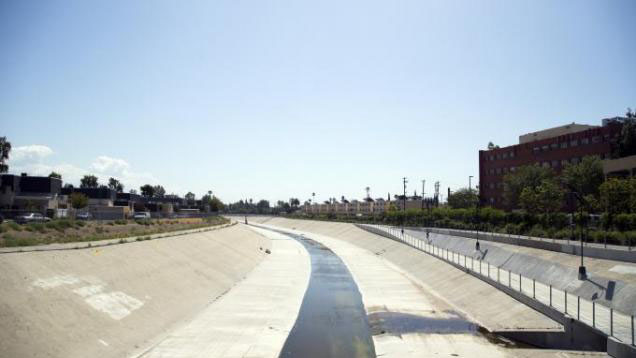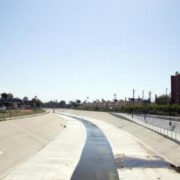
A survey of 600 multiethnic residents finds that majority of LA ethnic communities support LA River revitalization
SINCE the dawn of civilization, rivers have played an integral role in the building and preservation of villages, cities, and empires. Rivers are a key feature and asset to nearly every major metropolis across the United States — like New York, Chicago, San Antonio, and Boston, to name a few — as symbols of sustenance and innovation.
Los Angeles, a center of innovation in many ways, does have a river, but in the context of the great rivers of the United States, it leaves a lot to be desired.
Throughout the years, the Los Angeles River — which spans 51 miles from Canoga Park all the way to Long Beach — has gone through wavering periods of drought brought on by the growing threat of climate change.
But more importantly, it has been a site of plain neglect by the cities that border the river, which holds a lot of potential for neighborhoods closest to it.
As previously reported in the Asian Journal, the county — along with multiple municipal jurisdictions and environmental preservation agencies — has for the last couple of decades begun developing plans to restore the LA River.
According to the “LA River Master Plan,” which was released by LA County earlier this year, more than 1 million people across the county live within one mile of the river, making it an essential part of the landscape of not only LA City but the county at large.
The 480-page plan details more than 200 potential environmental and urban planning project sites that promise: local job creation; targeted efforts “that assist in mitigating future disasters such as flooding, drought, and extreme heat”; and initiatives to combat homelessness across the river while addressing displacement and gentrification.
Poor maintenance and carelessness on the part of residents and local governments are a major culprit of the river’s tragic state, but changes in the climate have also exacerbated conditions along the river’s vast stretch.
But that is starting to change, and the county says that the LA River Master Plan, which will span the next several decades, will be an essential blueprint for the river’s long-overdue restoration — and according to a recent survey of Angelenos, residents are all in.
In July, StudyLA — a research organization based at Loyola Marymount University (LMU) that strives for more equitable research-based advocacy for the greater LA area — conducted its 2021 Los Angeles River Survey, a 600-person study that sought to gauge residents’ attitudes and opinions regarding the LA River.
Each participant took part in a 15-minute telephone poll — which was conducted in four different languages: English, Spanish, Mandarin, and Korean — which found that 91% of Angelenos support revitalization efforts of the region’s most prominent water passage.
And, after a long period of shelter-in-home and social distancing, community leaders agree that the LA River has lots of potential to be a source of prosperity for Angelenos.
“When we started thinking and reimagining what a post-pandemic city is going to look like, the river should be upfront,” Fernando Guerra of LMU said at a Sept. 10 press briefing releasing the survey results. “We need to be outside [and] we need to have activities in the urban space, and thinking of a revitalized river is a great support for this effort.”
During the telephone survey, many questions were fielded to participants, including, “What comes to mind when you think of the Los Angeles River?” StudyLA created a word cloud of the most commonly spoken words during these telephone calls, and by far, the most prominent word was “dirty,” which presented a complicated issue.
“If you don’t think it’s worthy, you’re not going to invest. If you don’t invest, it will never be worthy. I think this is what that word speaks to me: that we have to have some initial investment to try to get people to understand the potential of this resource,” Guerra shared.
As written about in the Asian Journal, the history of the LA River goes back centuries. The river was a primary source of fresh water for indigenous Americans and wildlife and provided plenty of fish, including the now-endangered steelhead trout.
After colonists began settling in the area and the county started to transform into its current manifestation, the U.S. Army Corps of Engineers encased the river in a deep concrete trench following an intense rainfall in 1938 that caused flooding across the county.
These concrete trenches allowed for more pedestrian and recreational use, but Angelenos agree that the river could provide more in terms of multipurpose functionality.
The StudyLA poll found that many Angelenos supported more bicycle and pedestrian lanes as well as parks and recreational areas — the LA River Master Plan details a massive transformation of 32 miles of concrete-lined river to public green spaces.
Among poll participants, 82% support creating habitats for flora and fauna and 79% said that flood control is also a priority.
About 64% of Angelenos believe that the river could be a tourist attraction, which has been a goal since the Environmental Protection Agency (EPA) classified the LA River as a navigable waterway.
“What has been a singular purpose [in revitalization efforts] is to get water out quickly because of atmospheric flooding,” said Sarah Rascon, environmental equity officer of the Mountains Recreation and Conservation Authority. “But with this renewed focus, we realize that you can do so much more. The water quality is tested three times a week now, [and] there is recreation for everyone,” she added.
Notably, 76% of survey respondents said that any efforts to revitalize the river should not displace local communities and feed into the growing concern over gentrification.
In order to benefit “those who live along the [LA river] corridor, we have to tackle several issues,” said Mark Stanley, executive officer of the Rivers and Mountains Conservancy. “How do you look at encampment issues, how do you look at housing, how to integrate that into the open space, how do you look at the communities that want to create greater economic development, without creating displacement and gentrification?”
Gentrification has already impacted communities along the river, particularly the neighborhoods near Frogtown, Chinatown, Cypress Park, and Eagle Rock. At the Sept. 10 press conference, community advocates, like Damon Nagami — senior attorney at the Natural Resources Defense Council — noted that any and all river restoration projects must have these communities of color in mind.
“There are opportunities here for equitable community development, he said. “But we have to be intentional and build those policies.”
“It could be a resource for all of L.A. County, not just those that are by the river,” says Guerra of the L.A. River. “I certainly didn’t expect that, but it’s one of the major findings— how much support for investing in the river goes way beyond the neighborhoods by the river.”
However, although support for the river is overwhelmingly positive, only 48% support a tax increase to fund the revitalization effort.
But the State of California announced on Sept. 29 that it would commit to $15 million to fund two upcoming key restoration projects: $10 million toward the completion of the Glendale-LA River pedestrian and $5 million toward bicycle bridge and the creation of an under-crossing path along the North Atwater East Bank.
The latter, once completed, will allow pedestrians, cyclists, and equestrians to easily access parks, horse facilities, neighborhoods and businesses — integrating the river into the everyday lives of Angelenos.
“To be a great city, we need a great river,” Guerra said. “I think that Angelenos are coming around to that perspective. (Klarize Medenilla/AJPress)








I believe that going forward with the la river master plan projects will be a new fresh start and future for all of us to enjoy this beautiful amazing aquaduct full of wild life nature